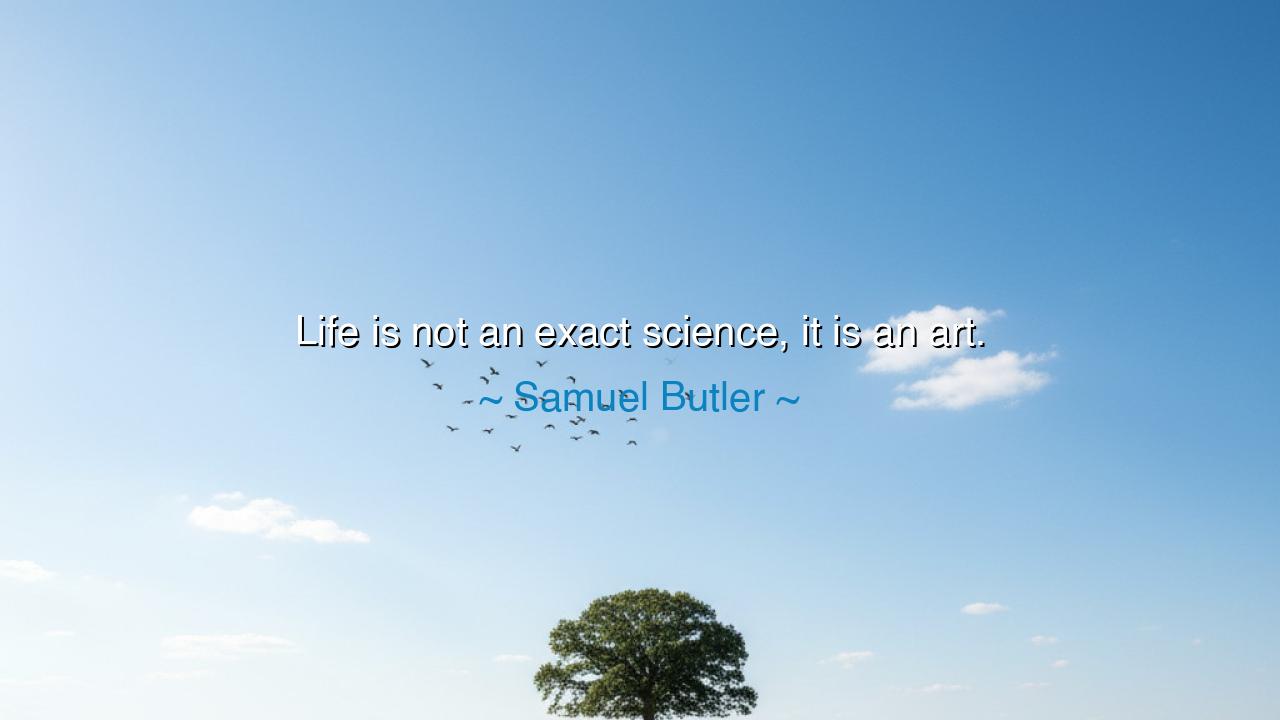
Life is not an exact science, it is an art.






"Life is not an exact science, it is an art." – Samuel Butler.
In these words, Samuel Butler reveals a profound truth about the human experience. Life, with all its complexity, cannot be reduced to mere rules or calculations. It is not something that can be perfectly predicted, measured, or understood like a science. Rather, it is like an art—a creative, dynamic expression that requires imagination, emotion, and intuition. Butler encourages us to see life not as a rigid framework, but as a canvas on which we create, shape, and improvise. Life’s beauty lies in its uncertainty, its fluidity, and the way we must engage with it, not with scientific precision, but with heart, courage, and vision.
The ancients understood this distinction between science and art in the context of life. Socrates famously claimed that knowledge alone was not sufficient to live a fulfilled life. Virtue, in his view, came from a deep engagement with life’s questions and choices—it required both wisdom and practical action, and could not be reduced to a mere set of scientific principles. Similarly, Aristotle distinguished between practical knowledge (or phronesis) and theoretical knowledge (or episteme). The first was concerned with living well—with making good choices in the complexities of daily life—while the latter was about understanding the world’s universal truths. For Aristotle, the good life was not one of exactitude and certainty but one of balance, reflection, and action that could never be reduced to formulae.
Consider the story of Leonardo da Vinci, a man who epitomized the blending of science and art. As a painter, scientist, and engineer, he understood that life’s mysteries could not be fully understood through one lens alone. His work on the Vitruvian Man combined his knowledge of anatomy with his artistic vision, creating an image that was both a scientific study and a symbol of beauty. Leonardo’s life was an embodiment of Butler’s sentiment—he did not see the world as a place to be measured and controlled but as a canvas to be explored, understood, and expressed through both art and science. Da Vinci’s genius lay in his ability to see life as an art—one that intertwined creativity and discovery, and this was the secret of his enduring influence.
The idea of life as an art is also reflected in the life of Mahatma Gandhi, whose approach to freedom and justice was shaped not by calculations or exact science, but by a profound understanding of the human spirit. Gandhi’s commitment to non-violence was not a theoretical, scientific principle; it was a deeply personal commitment to seeing the world not in terms of rigid systems, but in terms of human dignity and compassion. His success in leading India to independence was not a product of scientific strategy, but of a vision, a philosophy, and a personal commitment to the art of living in harmony with the world. He navigated the complexities of politics, social issues, and human relationships not with scientific precision but with imagination, patience, and a creative, yet deeply rooted, approach to change.
Butler’s insight reminds us that life is a dynamic process, one that cannot be reduced to the certainty of science. Unlike a laboratory experiment, life is an unfolding story, full of ambiguities, choices, and unexpected outcomes. Certainty in life is a delusion, and the pursuit of perfection is often a distraction from the true beauty of living. Like an artist standing before a blank canvas, we are each given the freedom to choose, create, and adapt. The messiness of life—its struggles, uncertainties, and challenges—are what give it its richness. The art of living is found in embracing the unknown, in making choices with courage, and in finding beauty in the imperfections.
The lesson from Butler’s quote is that living well requires creativity, not just intellect. We must embrace life’s uncertainties, its complexities, and its challenges, rather than seeking to control them. Life is about making choices—not just relying on rules or scientific understanding, but about trusting in our intuition, values, and imagination. The true measure of success in life is not in how perfectly we follow prescribed formulas, but in how well we engage with the world, create meaning, and express our deepest beliefs and desires.
In our own lives, we must learn to treat each day as a work of art—a creative process that requires our engagement, imagination, and wisdom. We must not get caught up in the perfection of science or the expectations of others. Instead, we should embrace life’s beautiful uncertainty and approach it with the same courage and creativity as an artist facing a blank canvas. Through choice, action, and reflection, we create our own masterpiece. Life is not about the rigid adherence to systems but about finding meaning and beauty in the process of living.






AAdministratorAdministrator
Welcome, honored guests. Please leave a comment, we will respond soon